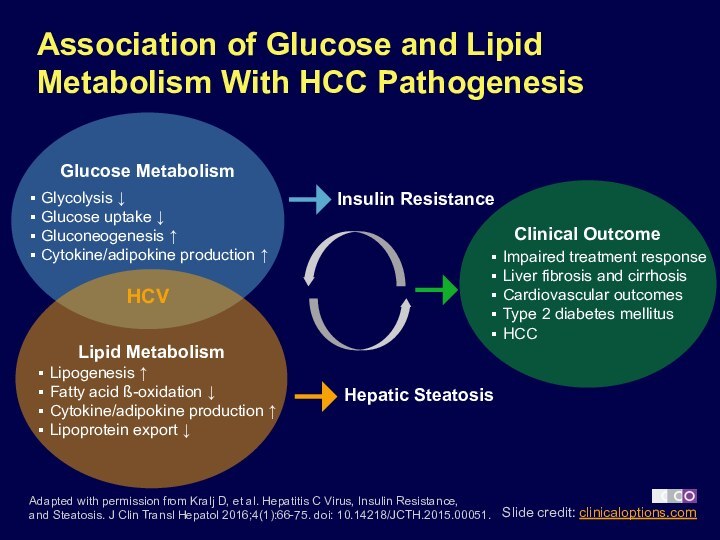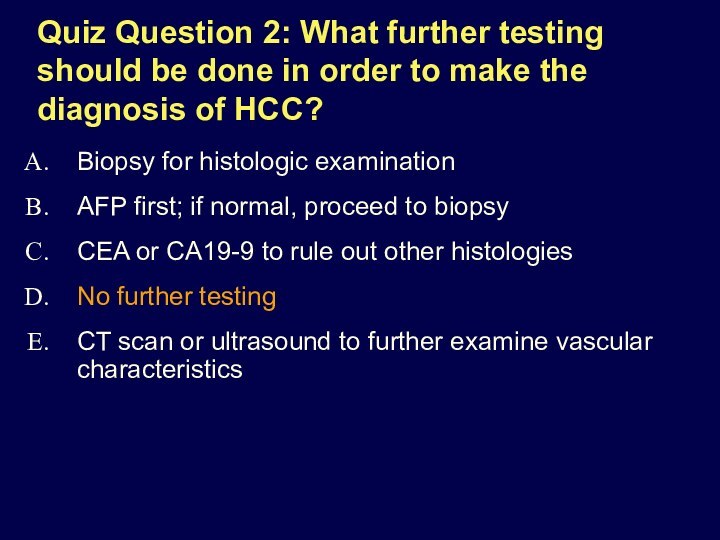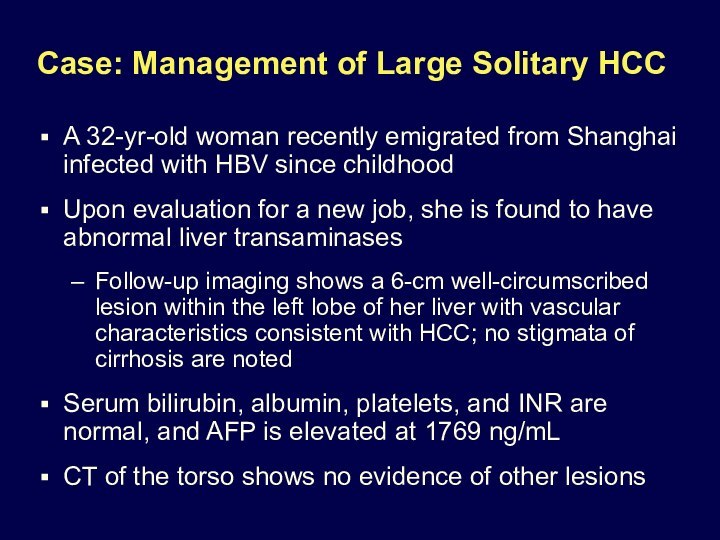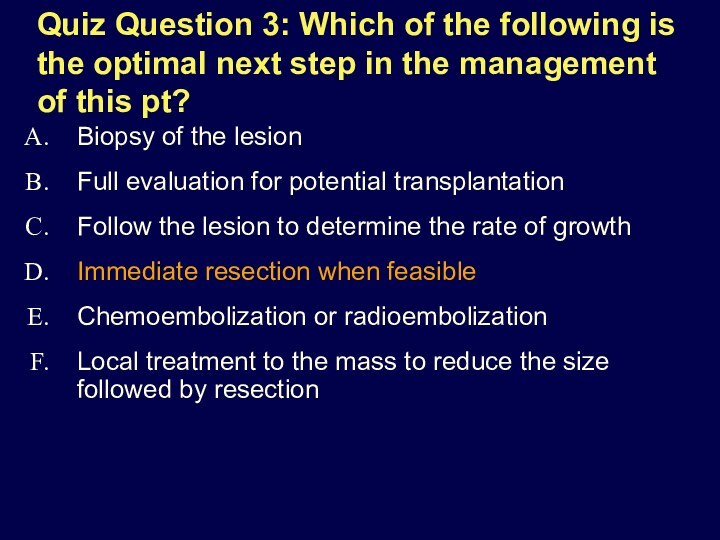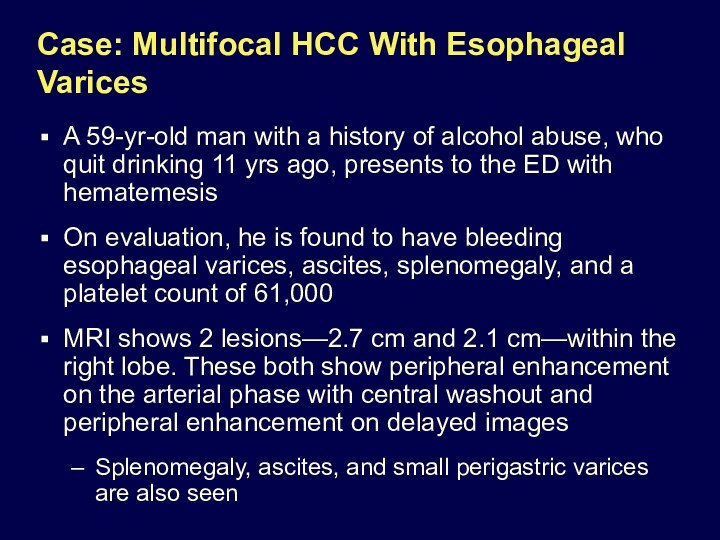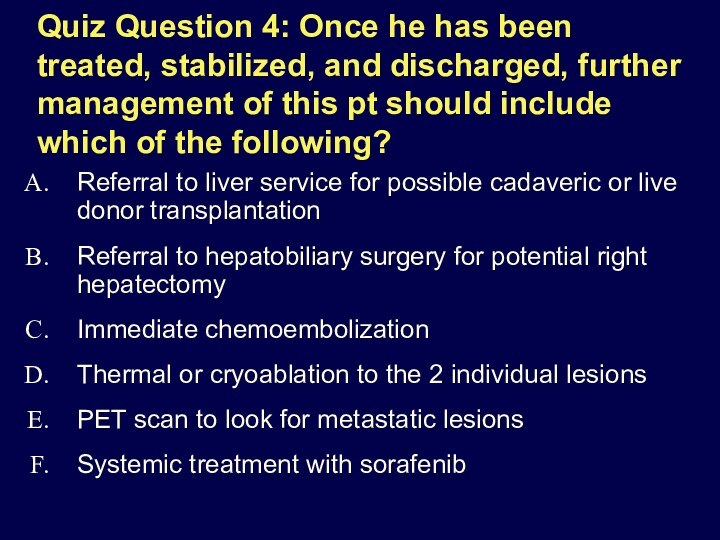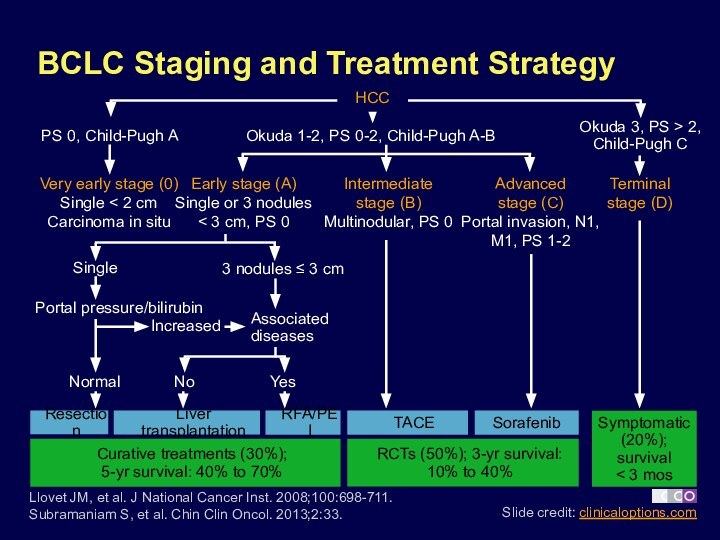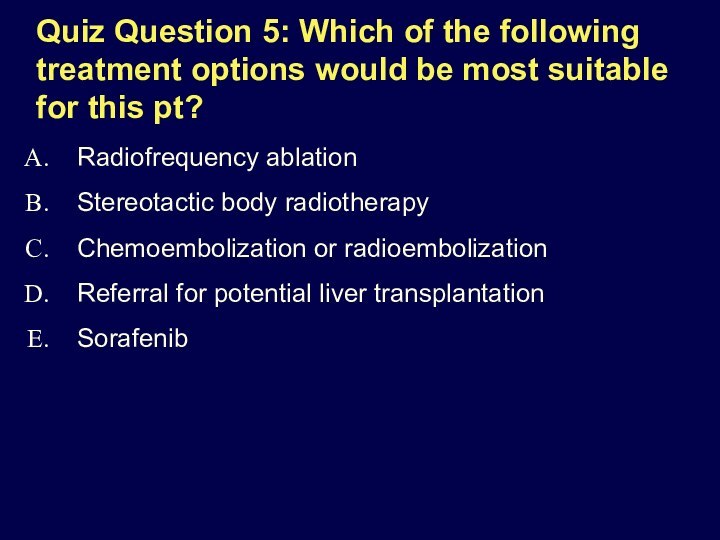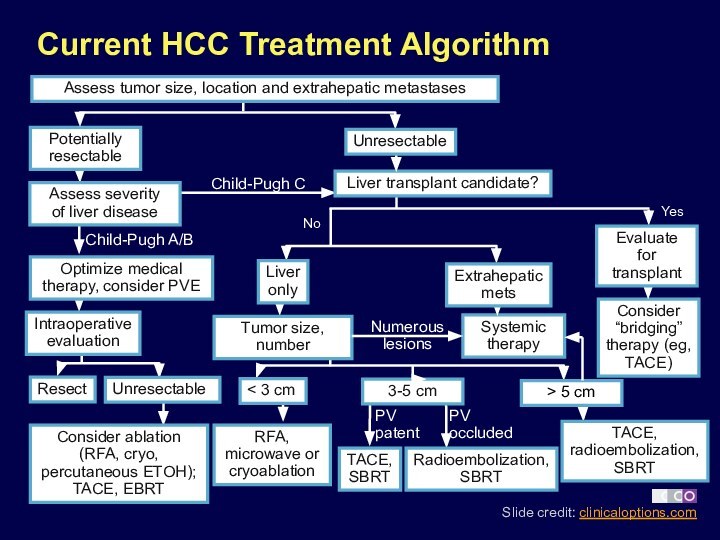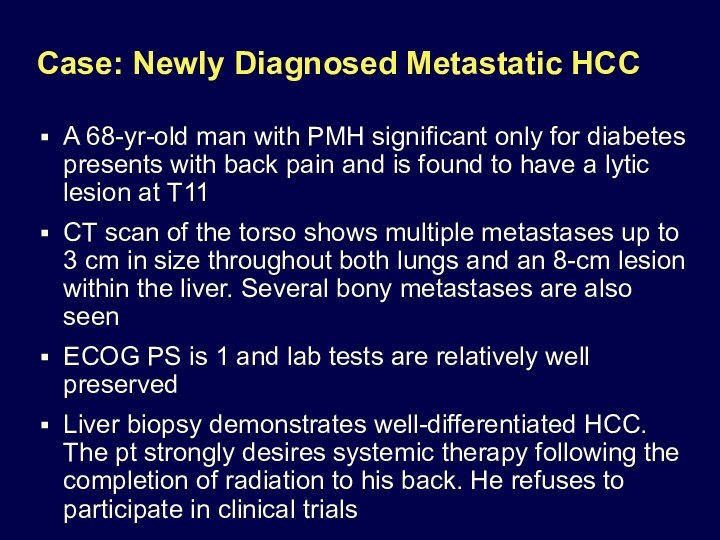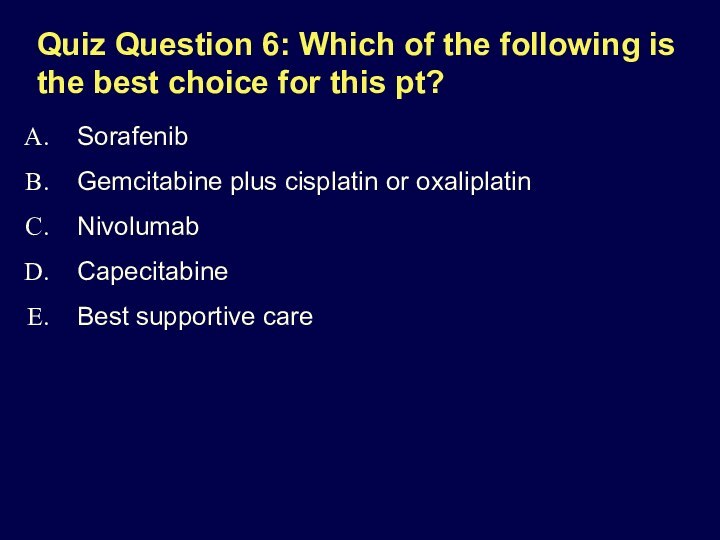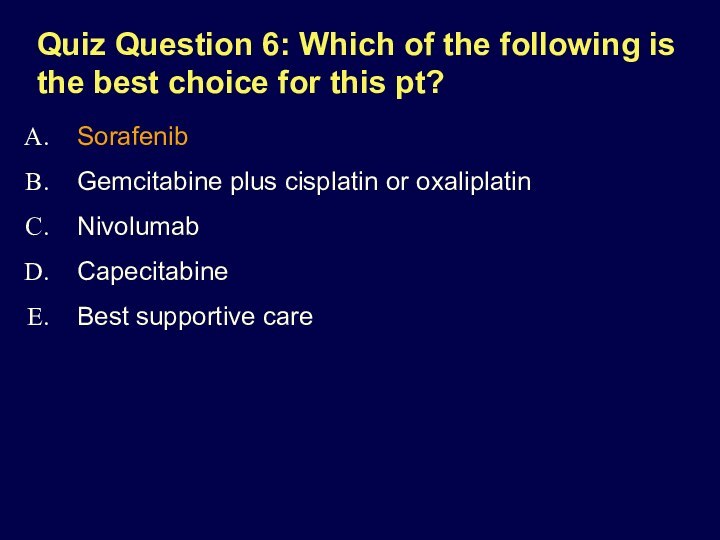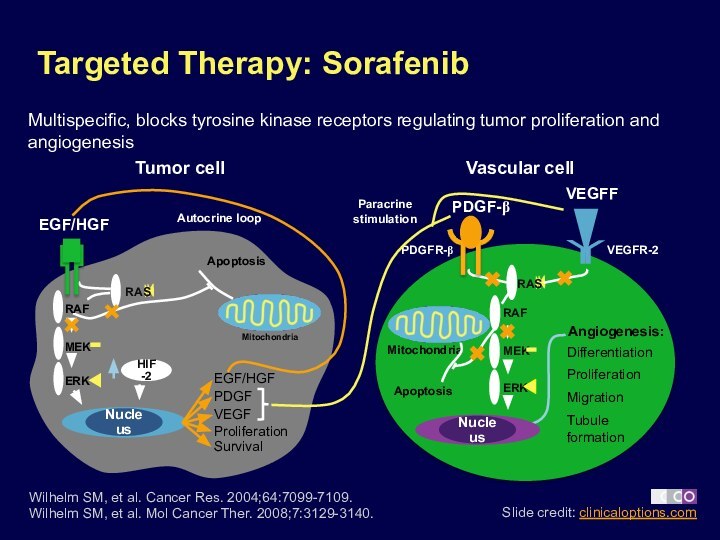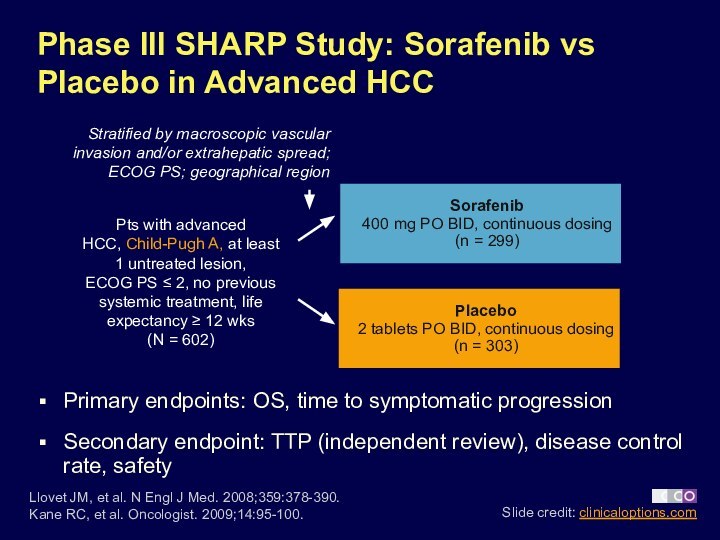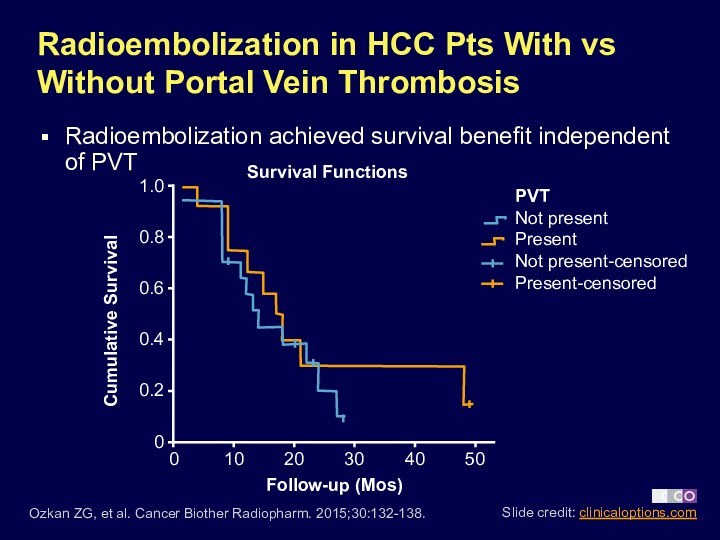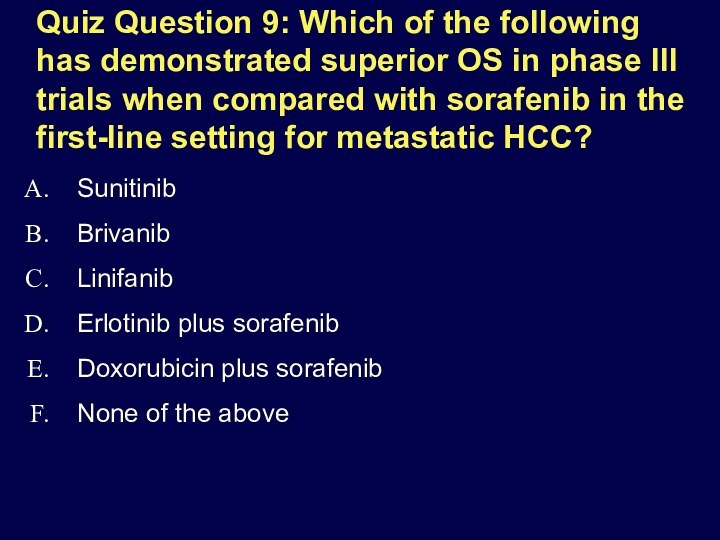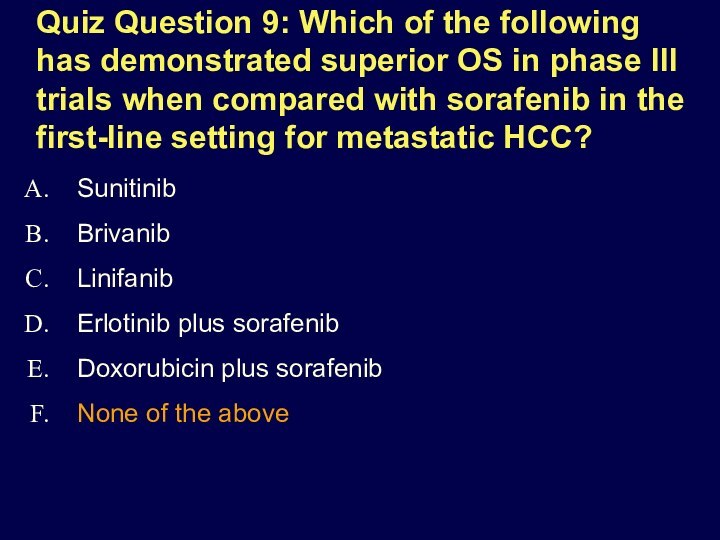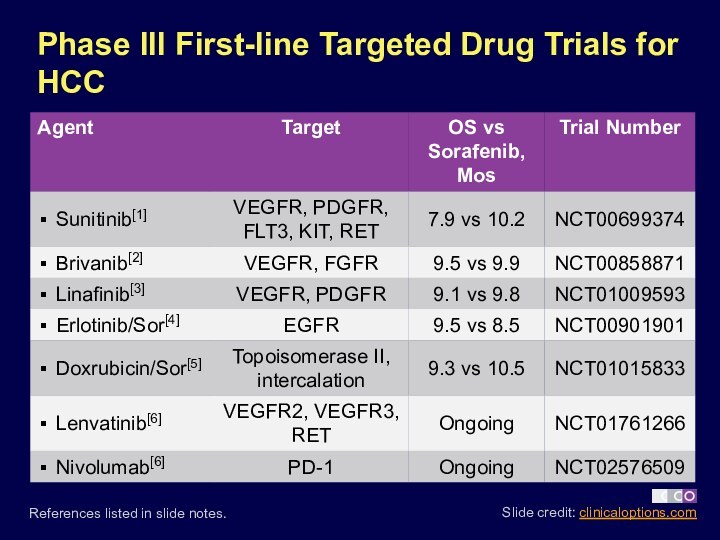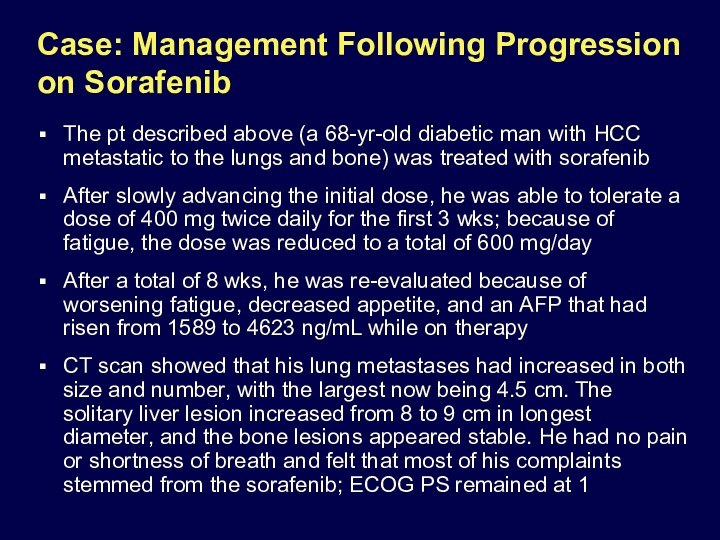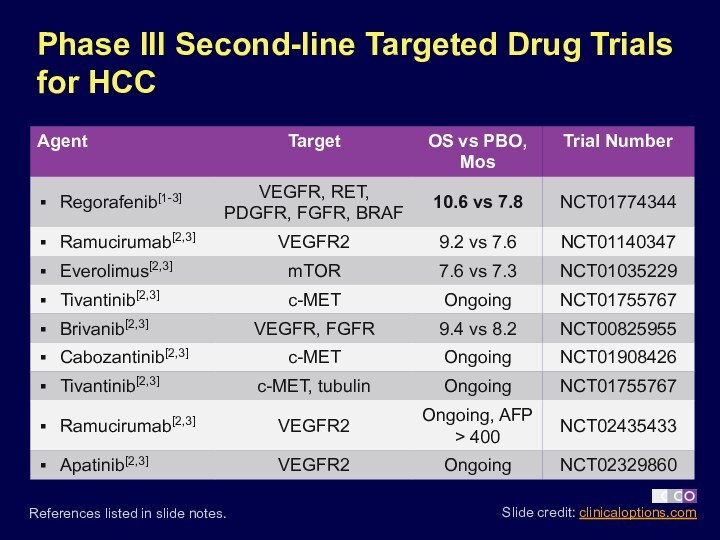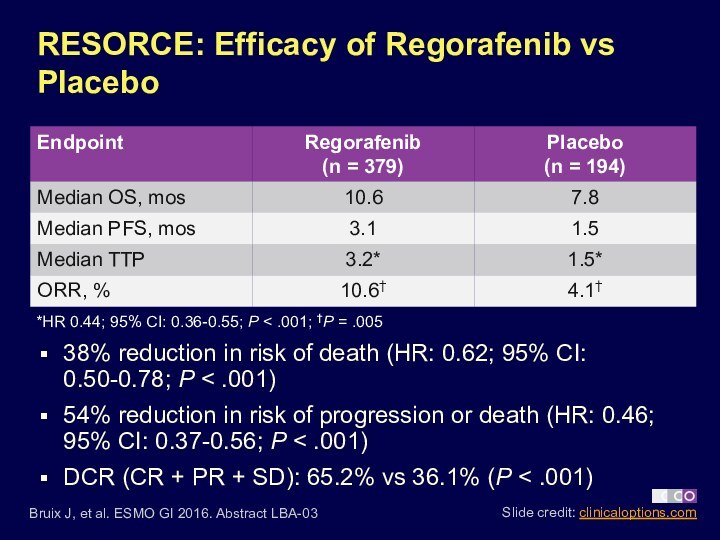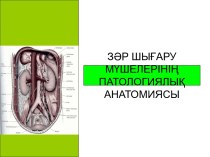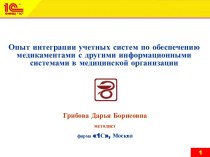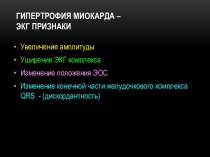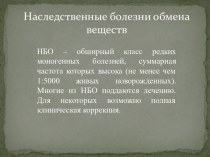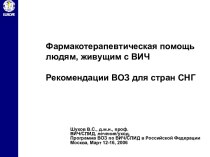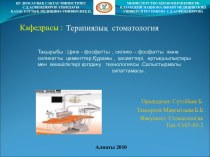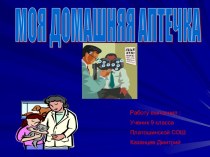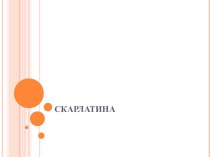Слайд 2
About These Slides
Please feel free to use, update,
and share some or all of these slides in
your noncommercial presentations to colleagues or patients
When using our slides, please retain the source attribution:
These slides may not be published, posted online, or used in commercial presentations without permission. Please contact permissions@clinicaloptions.com for details
Слайд 3
Quiz Question 1: The incidence of HCC in
the United States has tripled over the past 20
yrs. Which of the following best explains the expected continued increase in HCC incidence in the US?
HBV infection
HCV infection
Diabetes mellitus and obesity
Alcohol abuse
Aflatoxin ingestion
Hemochromatosis
Cigarette smoking
Слайд 4
Quiz Question 1: The incidence of HCC in
the United States has tripled over the past 20
yrs. Which of the following best explains the expected continued increase in HCC incidence in the US?
HBV infection
HCV infection
Diabetes mellitus and obesity
Alcohol abuse
Aflatoxin ingestion
Hemochromatosis
Cigarette smoking
Слайд 5
Age-Adjusted Incidence of HCC by Race 1975-2007
Incidence consistently
higher among Asian population
Mittal S, et al. J Clin
Gastroenterol. 2013;47:S2-S6.
12
10
8
6
4
2
0
Rate per 100,000
White
Black
Asian
Hispanic
1975-1977
1993-1995
2005-2007
1.2
2.0
3.7
2.8
4.0
7.6
6.6
8.4
10.3
4.3
8.2
Слайд 6
2016 Estimated US Cancer Deaths
Liver cancer in 2016
estimated as:
The #5 cancer killer in men (up from
#7 in 2005)
The #8 cancer killer in women (not among top 10 in 2005)
Siegel R, et al. CA Cancer J Clin. 2016;66:7-30.
Слайд 7
Association of Glucose and Lipid Metabolism With HCC
Pathogenesis
Glucose Metabolism
Lipid Metabolism
Glycolysis ↓
Glucose uptake ↓
Gluconeogenesis ↑
Cytokine/adipokine production ↑
Lipogenesis
↑
Fatty acid ß-oxidation ↓
Cytokine/adipokine production ↑
Lipoprotein export ↓
HCV
Clinical Outcome
Impaired treatment response
Liver fibrosis and cirrhosis
Cardiovascular outcomes
Type 2 diabetes mellitus
HCC
Hepatic Steatosis
Insulin Resistance
Adapted with permission from Kralj D, et al. Hepatitis C Virus, Insulin Resistance,
and Steatosis. J Clin Transl Hepatol 2016;4(1):66-75. doi: 10.14218/JCTH.2015.00051.
Слайд 8
Case: Diagnosis of HCC
62-yr-old man referred to your
clinic with history of self-administered tattoos
Saw a television ad
about HCV and decided to see his physician; found to be positive for HCV
Screening MRI: splenomegaly, hepatic nodularity consistent with cirrhosis, and 2.6-cm lesion in right lobe of liver that showed rapid arterial enhancement with significant washout on delayed images
Слайд 9
Quiz Question 2: What further testing should be
done in order to make the diagnosis of HCC?
Biopsy
for histologic examination
AFP first; if normal, proceed to biopsy
CEA or CA19-9 to rule out other histologies
No further testing
CT scan or ultrasound to further examine vascular characteristics
Слайд 10
Quiz Question 2: What further testing should be
done in order to make the diagnosis of HCC?
Biopsy
for histologic examination
AFP first; if normal, proceed to biopsy
CEA or CA19-9 to rule out other histologies
No further testing
CT scan or ultrasound to further examine vascular characteristics
Слайд 11
Diagnosis of HCC by MRI Imaging
Baird AJ, et
al. J Med Imaging Radiat Oncol. 2013;57:314-320.
T1 image: isointense
tumor
T2 image: hyperintense tumor
T1 arterial phase: arterial enhancement
T1 portal phase: rapid portal venous phase washout
T1 20-min delayed image: hypointense tumor
Слайд 12
Case: Management of Large Solitary HCC
A 32-yr-old woman
recently emigrated from Shanghai infected with HBV since childhood
Upon
evaluation for a new job, she is found to have abnormal liver transaminases
Follow-up imaging shows a 6-cm well-circumscribed lesion within the left lobe of her liver with vascular characteristics consistent with HCC; no stigmata of cirrhosis are noted
Serum bilirubin, albumin, platelets, and INR are normal, and AFP is elevated at 1769 ng/mL
CT of the torso shows no evidence of other lesions
Слайд 13
Quiz Question 3: Which of the following is
the optimal next step in the management of this
pt?
Biopsy of the lesion
Full evaluation for potential transplantation
Follow the lesion to determine the rate of growth
Immediate resection when feasible
Chemoembolization or radioembolization
Local treatment to the mass to reduce the size followed by resection
Слайд 14
Quiz Question 3: Which of the following is
the optimal next step in the management of this
pt?
Biopsy of the lesion
Full evaluation for potential transplantation
Follow the lesion to determine the rate of growth
Immediate resection when feasible
Chemoembolization or radioembolization
Local treatment to the mass to reduce the size followed by resection
Слайд 15
Curative Treatments
Transplant
Cures both cirrhosis and HCC
MELD exception
Milan criteria
Downsizing
Demand
> supply
Survival
1 yr: 91%
2 yrs: 75%
5 yrs:
> 70%
Recurrence
5 yrs: < 15%
Ablation
Effective when
≤ 3 cm
Multiple modalities
Thermal
Chemical
Minimally invasive
Survival
1 yr: 90%
3 yrs: 75%
5 yrs: 60% to 70%
Recurrence
5 yrs: 70%
Resection
Noncirrhotics
Choice of therapy
Cirrhotics
Reserve for CTP A
Avoid R hepatectomy
Best for solitary HCC
Only 5% to 15% eligible
Survival
1 yr: 95%
3 yrs: 85%
5 yrs: 50%
Recurrence
5 yrs: 70%
NCCN Guidelines. Hepatobiliary Cancers. Version 2.2016.
Слайд 16
Survival After Resection for HCC
Of 1265 pts with
HCC evaluated, only 35 were ideal candidates for resection
Llovet
JM, et al. Hepatology. 1999;30:1434-1440.
Survival (%)
Mos
Log-rank P = .00001
Portal hypertension, normal bilirubin
No portal hypertension, normal bilirubin
Portal hypertension, bilirubin ≥ 1 mg/dL
Слайд 17
Case: Multifocal HCC With Esophageal Varices
A 59-yr-old man
with a history of alcohol abuse, who quit drinking
11 yrs ago, presents to the ED with hematemesis
On evaluation, he is found to have bleeding esophageal varices, ascites, splenomegaly, and a platelet count of 61,000
MRI shows 2 lesions—2.7 cm and 2.1 cm—within the right lobe. These both show peripheral enhancement on the arterial phase with central washout and peripheral enhancement on delayed images
Splenomegaly, ascites, and small perigastric varices are also seen
Слайд 18
Quiz Question 4: Once he has been treated,
stabilized, and discharged, further management of this pt should
include which of the following?
Referral to liver service for possible cadaveric or live donor transplantation
Referral to hepatobiliary surgery for potential right hepatectomy
Immediate chemoembolization
Thermal or cryoablation to the 2 individual lesions
PET scan to look for metastatic lesions
Systemic treatment with sorafenib
Слайд 19
Quiz Question 4: Once he has been treated,
stabilized, and discharged, further management of this pt should
include which of the following?
Referral to liver service for possible cadaveric or live donor transplantation
Referral to hepatobiliary surgery for potential right hepatectomy
Immediate chemoembolization
Thermal or cryoablation to the 2 individual lesions
PET scan to look for metastatic lesions
Systemic treatment with sorafenib
Слайд 20
Liver transplantation
RFA/PEI
Curative treatments (30%);
5-yr survival: 40% to
70%
TACE
Single
Increased
Associated
diseases
Normal
No
Yes
Sorafenib
Portal pressure/bilirubin
3 nodules ≤ 3 cm
Resection
Symptomatic (20%); survival
3 mos
RCTs (50%); 3-yr survival:
10% to 40%
Terminal
stage (D)
Okuda 1-2, PS 0-2, Child-Pugh A-B
Intermediate
stage (B)
Multinodular, PS 0
Okuda 3, PS > 2,
Child-Pugh C
Very early stage (0)
Single < 2 cm
Carcinoma in situ
Early stage (A)
Single or 3 nodules
< 3 cm, PS 0
Advanced
stage (C)
Portal invasion, N1, M1, PS 1-2
PS 0, Child-Pugh A
HCC
BCLC Staging and Treatment Strategy
Llovet JM, et al. J National Cancer Inst. 2008;100:698-711.
Subramaniam S, et al. Chin Clin Oncol. 2013;2:33.
Слайд 21
Case: Large Solitary HCC With Preserved Liver Function
A
71-yr-old asymptomatic man with a history of hemochromatosis goes
to a new gastroenterologist and is found to have a 7-cm mass in the right lobe consistent with HCC
He is not a surgical candidate because of significant cardiovascular disease but has relatively well-preserved hepatic function
Слайд 22
Quiz Question 5: Which of the following treatment
options would be most suitable for this pt?
Radiofrequency ablation
Stereotactic
body radiotherapy
Chemoembolization or radioembolization
Referral for potential liver transplantation
Sorafenib
Слайд 23
Quiz Question 5: Which of the following treatment
options would be most suitable for this pt?
Radiofrequency ablation
Stereotactic
body radiotherapy
Chemoembolization or radioembolization
Referral for potential liver transplantation
Sorafenib
Слайд 24
Current HCC Treatment Algorithm
Potentially
resectable
Assess severity
of liver disease
Liver transplant
candidate?
Optimize medical
therapy, consider PVE
Intraoperative
evaluation
Resect
Unresectable
Consider ablation (RFA, cryo, percutaneous ETOH);
TACE, EBRT
Child-Pugh A/B
Child-Pugh C
Consider
“bridging”
therapy (eg,
TACE)
Systemic
therapy
RFA, microwave or
cryoablation
Numerous lesions
Assess tumor size, location and extrahepatic metastases
Yes
No
Liver
only
Extrahepatic
mets
< 3 cm
Evaluate
for transplant
3-5 cm
Tumor size, number
Unresectable
TACE, SBRT
PV patent
Radioembolization, SBRT
PV occluded
> 5 cm
TACE, radioembolization, SBRT
Слайд 25
Case: Newly Diagnosed Metastatic HCC
A 68-yr-old man with
PMH significant only for diabetes presents with back pain
and is found to have a lytic lesion at T11
CT scan of the torso shows multiple metastases up to 3 cm in size throughout both lungs and an 8-cm lesion within the liver. Several bony metastases are also seen
ECOG PS is 1 and lab tests are relatively well preserved
Liver biopsy demonstrates well-differentiated HCC. The pt strongly desires systemic therapy following the completion of radiation to his back. He refuses to participate in clinical trials
Слайд 26
Quiz Question 6: Which of the following is
the best choice for this pt?
Sorafenib
Gemcitabine plus cisplatin or
oxaliplatin
Nivolumab
Capecitabine
Best supportive care
Слайд 27
Quiz Question 6: Which of the following is
the best choice for this pt?
Sorafenib
Gemcitabine plus cisplatin or
oxaliplatin
Nivolumab
Capecitabine
Best supportive care
Слайд 28
Targeted Therapy: Sorafenib
Wilhelm SM, et al. Cancer
Res. 2004;64:7099-7109.
Wilhelm SM, et al. Mol Cancer Ther.
2008;7:3129-3140.
RAS
Vascular cell
Angiogenesis:
VEGFF
VEGFR-2
PDGFR-β
Paracrine
stimulation
Mitochondria
Apoptosis
Tumor cell
PDGF
VEGF
EGF/HGF
Proliferation
Survival
Mitochondria
HIF-2
Nucleus
Autocrine loop
Apoptosis
ERK
RAS
MEK
RAF
Nucleus
ERK
MEK
RAF
Differentiation
Proliferation
Migration
Tubule formation
PDGF-β
EGF/HGF
Multispecific, blocks tyrosine kinase receptors regulating tumor proliferation and angiogenesis
Слайд 29
Phase III SHARP Study: Sorafenib vs Placebo in
Advanced HCC
Primary endpoints: OS, time to symptomatic progression
Secondary endpoint:
TTP (independent review), disease control rate, safety
Stratified by macroscopic vascular invasion and/or extrahepatic spread; ECOG PS; geographical region
Pts with advanced
HCC, Child-Pugh A, at least
1 untreated lesion,
ECOG PS ≤ 2, no previous systemic treatment, life expectancy ≥ 12 wks
(N = 602)
Sorafenib
400 mg PO BID, continuous dosing
(n = 299)
Placebo
2 tablets PO BID, continuous dosing
(n = 303)
Llovet JM, et al. N Engl J Med. 2008;359:378-390.
Kane RC, et al. Oncologist. 2009;14:95-100.
Слайд 30
SHARP: Overall Survival
Sorafenib improved OS vs placebo in
unresectable HCC
Llovet JM, et al. N Engl J Med.
2008;359:378-390.
Kane RC, et al. Oncologist. 2009;14:95-100.
Слайд 31
SHARP: Treatment-Emergent AEs
Kane RC, et al. Oncologist. 2009:14;95-100.
Слайд 32
Case: Multifocal HCC With Portal Vein Thrombosis
A 53-yr-old
asymptomatic man without significant past medical history comes in
for a checkup. He is worried because his old college roommate, with whom he briefly shared needles, was recently diagnosed with HCV. He also tests positive for HCV
Screening ultrasound shows two ~ 4-cm lesions within the liver, along with portal vein thrombosis and a small amount of ascites
AFP is elevated at 845 ng/mL, and his serum bilirubin is 2 x ULN
This pt is not interested in clinical trials
Слайд 33
Quiz Question 7: Which of the following is
the optimal treatment choice for this pt?
Referral for liver
transplantation
Sorafenib
Microwave ablation
Chemoembolization
Radioembolization
Слайд 34
Quiz Question 7: Which of the following is
the optimal treatment choice for this pt?
Referral for liver
transplantation
Sorafenib
Microwave ablation
Chemoembolization
Radioembolization
Слайд 35
Radioembolization in HCC Pts With vs Without Portal
Vein Thrombosis
Radioembolization achieved survival benefit independent of PVT
Ozkan ZG,
et al. Cancer Biother Radiopharm. 2015;30:132-138.
Survival Functions
PVT
Not present
Present
Not present-censored
Present-censored
Cumulative Survival
Follow-up (Mos)
1.0
0.8
0.4
0.2
0
0
0.6
10
20
30
40
50
Слайд 36
Quiz Question 8: In which situation has adjuvant
therapy for HCC been shown to be effective?
Sorafenib following
surgical resection
Sorafenib following chemoembolization
Doxorubicin following liver transplantation
Sorafenib following radiofrequency ablation
Lipiodol I-131 given intra-arterially following resection
None of the above
Слайд 37
Quiz Question 8: In which situation has adjuvant
therapy for HCC been shown to be effective?
Sorafenib following
surgical resection
Sorafenib following chemoembolization
Doxorubicin following liver transplantation
Sorafenib following radiofrequency ablation
Lipiodol I-131 given intra-arterially following resection
None of the above
Слайд 38
Phase II START Trial: TACE + Sorafenib in
Asian Pts With HCC
TACE + sorafenib effective and well
tolerated in Asian pts with HCC
Chao Y, et al. Int J Cancer. 2015;136:1458-1467.
1.0
0.8
0.6
0.4
0.2
0
Pts at risk, n
0
192
100
171
300
142
400
126
500
115
600
103
700
98
800
94
900
93
200
155
1000
93
Days From Cycle 1
Probability of PFS
Lower 95% CI
Survival
Upper 95% CI
Censored
Слайд 39
Quiz Question 9: Which of the following has
demonstrated superior OS in phase III trials when compared
with sorafenib in the first-line setting for metastatic HCC?
Sunitinib
Brivanib
Linifanib
Erlotinib plus sorafenib
Doxorubicin plus sorafenib
None of the above
Слайд 40
Quiz Question 9: Which of the following has
demonstrated superior OS in phase III trials when compared
with sorafenib in the first-line setting for metastatic HCC?
Sunitinib
Brivanib
Linifanib
Erlotinib plus sorafenib
Doxorubicin plus sorafenib
None of the above
Слайд 41
Phase III First-line Targeted Drug Trials for HCC
References listed in slide notes.
Слайд 42
Case: Management Following Progression on Sorafenib
The pt described
above (a 68-yr-old diabetic man with HCC metastatic to
the lungs and bone) was treated with sorafenib
After slowly advancing the initial dose, he was able to tolerate a dose of 400 mg twice daily for the first 3 wks; because of fatigue, the dose was reduced to a total of 600 mg/day
After a total of 8 wks, he was re-evaluated because of worsening fatigue, decreased appetite, and an AFP that had risen from 1589 to 4623 ng/mL while on therapy
CT scan showed that his lung metastases had increased in both size and number, with the largest now being 4.5 cm. The solitary liver lesion increased from 8 to 9 cm in longest diameter, and the bone lesions appeared stable. He had no pain or shortness of breath and felt that most of his complaints stemmed from the sorafenib; ECOG PS remained at 1
Слайд 43
Quiz Question 10: Which of the following agents
was shown in a phase III trial to improve
OS in pts who have disease progression following treatment with sorafenib?
Nivolumab
Everolimus
Brivanib
Regorafenib
Ramucirumab
None of the above
Слайд 44
Quiz Question 10: Which of the following agents
was shown in a phase III trial to improve
OS in pts who have disease progression following treatment with sorafenib?
Nivolumab
Everolimus
Brivanib
Regorafenib
Ramucirumab
None of the above
Слайд 45
Phase III Second-line Targeted Drug Trials for HCC
References listed in slide notes.
Слайд 46
Phase III RESORCE: Regorafenib in HCC After Progression
on Sorafenib
Randomized, double-blind phase III trial
Primary endpoint: OS
(ITT)
Secondary endpoints: PFS, TTP, RR, DCR
Bruix J, et al. ESMO GI 2016. Abstract LBA-03.
Pts with BCLC stage B or C HCC; documented PD on sorafenib ≥ 20 days at ≥ 400 mg/day; Child-Pugh A liver function;
ECOG PS 0-1
(N = 573)
Regorafenib + BSC
160 mg PO daily Wks 1-3
(n = 379)
Placebo + BSC
PO daily Wks 1-3
(n = 194)
Randomized 2:1
All pts treated until PD, death, or unacceptable toxicity
4-wk cycles
Слайд 47
RESORCE: Efficacy of Regorafenib vs Placebo
38% reduction in
risk of death (HR: 0.62; 95% CI: 0.50-0.78; P
< .001)
54% reduction in risk of progression or death (HR: 0.46; 95% CI: 0.37-0.56; P < .001)
DCR (CR + PR + SD): 65.2% vs 36.1% (P < .001)
*HR 0.44; 95% CI: 0.36-0.55; P < .001; †P = .005
Bruix J, et al. ESMO GI 2016. Abstract LBA-03
Слайд 48
RESORCE: Safety
Bruix J, et al. ESMO GI 2016.
Abstract LBA-03






